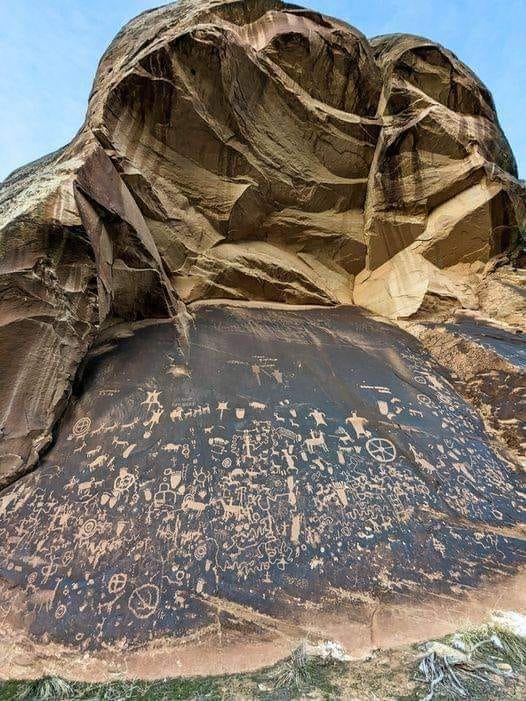Deep in the heart of Indian Creek State Park, Utah, lies a mesmerizing archaeological treasure that has fascinated researchers and visitors for countless generations. Newspaper Rock, a sprawling 200-square-foot sandstone canvas, is an enduring symbol of the rich cultural heritage of Native American civilization. This remarkable site offers a glimpse into the artistic and communicative practices of ancient peoples, revealing a narrative carved in stone that spans thousands of years.
The varnished surface of Newspaper Rock is adorned with hundreds of intricate petroglyphs, some of which date back as far as 1,500 BCE. These carvings, created by various indigenous groups, including the Ancestral Puebloans, Fremont, and Navajo tribes, form one of the most extraordinary outdoor galleries in North America. This “living chronicle,” etched into the stone, stands as a testament to the creativity, spirituality, and cultural depth of the people who inhabited these lands long before written records existed.

The stories told by Newspaper Rock are as diverse as the symbols themselves. Human figures in distinct poses, many adorned with unique clothing or headdresses, are juxtaposed with depictions of animals such as buffalo, deer, and serpents. Among these are curious representations of creatures that resemble hyenas, suggesting the wide array of fauna that ancient inhabitants encountered or revered. Interspersed with these figures are intricate geometric patterns, including spirals, circles, and elaborate designs, which weave together to create a tapestry of symbolic communication.
Despite decades of study, the precise meanings of many of these carvings remain elusive. Some archaeologists believe the petroglyphs serve as historical records, chronicling key events such as hunting expeditions, battles, or ceremonial gatherings. Others propose that these symbols reflect spiritual beliefs, perhaps documenting sacred rituals or conveying messages meant for the gods or future generations. The truth likely encompasses a combination of these interpretations, as each symbol carries layers of cultural significance that are deeply tied to the worldview of its creators.
One of the most compelling aspects of Newspaper Rock is its role as a communal hub of communication. Over the centuries, various tribes contributed their own carvings to this natural canvas, creating a layered narrative that transcends time. It is as if each generation left its mark, adding new chapters to a shared story. This unique characteristic transforms Newspaper Rock from a simple archaeological site into a dynamic cultural artifact—a bulletin board of sorts, where messages from different eras converge.
Today, Newspaper Rock is recognized as an invaluable historical site, protected to ensure its preservation for future generations. Conservation efforts are vital in safeguarding the delicate carvings from the effects of weathering, human activity, and natural erosion. These measures, which include controlled access and regular monitoring, help maintain the integrity of this ancient monument. Visitors are encouraged to admire the site responsibly, understanding the importance of preserving this irreplaceable link to the past.
The enduring mystery of Newspaper Rock lies not only in the meanings of its symbols but also in its ability to captivate the human imagination. Each spiral, geometric shape, and figure invites speculation, urging viewers to piece together the stories encoded within the rock’s surface. For archaeologists, this site remains a source of inspiration and inquiry, offering new discoveries with each analysis. For visitors, it provides a rare opportunity to connect with the ancient world in a tangible and profound way.
As we gaze upon the petroglyphs, we are reminded of the universal human desire to communicate and leave a mark on the world. The artists who carved these symbols may have lived thousands of years ago, but their messages resonate across the millennia. They tell of a time when the land was wild, life was shaped by the rhythms of nature, and every carving carried profound meaning for those who created it.
Newspaper Rock is not merely a historical artifact; it is a bridge that connects us to the people and cultures that once thrived in the rugged landscapes of Utah. It serves as a poignant reminder of our shared human heritage and the timeless drive to document our existence. Whether as an expression of art, spirituality, or historical record, the petroglyphs represent a dialogue between the past and the present, inviting us to ponder the lives and beliefs of those who came before us.
The legacy of Newspaper Rock endures, offering invaluable insights into the cultural and spiritual practices of ancient Native American tribes. Its carvings, etched with precision and care, provide a window into a world that modern society can only begin to comprehend. As we continue to study and preserve this extraordinary site, we honor not only the craftsmanship of its creators but also their enduring connection to the land and the stories it holds.
In every line and curve carved into the rock, there is a sense of purpose and reverence. Newspaper Rock is a masterpiece of human expression, standing as a testament to the ingenuity and resilience of ancient peoples. As visitors stand before this monumental canvas, they are invited to reflect on their own place in history, considering the ways in which they, too, leave their marks for future generations to discover and interpret. Through this connection, Newspaper Rock continues to inspire awe and wonder, ensuring that its messages will endure for centuries to come.





